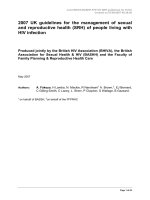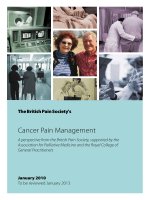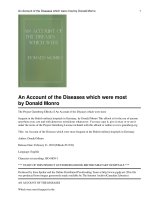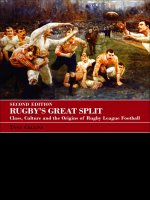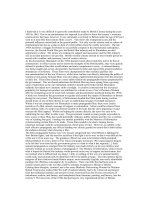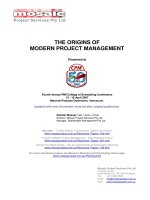The origins of the british
Bạn đang xem bản rút gọn của tài liệu. Xem và tải ngay bản đầy đủ của tài liệu tại đây (7.88 MB, 524 trang )
Tai Lieu Chat Luong
‘StephenOppenheimeristhesupremegeneticdetectivefishingforevidencein
thegene-poolsofhistory.’ProfessorCliveGamble,UniversityofLondon
‘HeupendssomeofthemostdeeplyrootednotionsofwheretheBritishpeople
come from, and does so in a clear, painstaking and detailed way. The result is
bothfascinatingandunexpected.’Geographical
‘The historians’ account is wrong in almost every detail. In Dr Oppenheimer’s
reconstruction of events, the principal ancestors of today’s British and Irish
populationsarrivedfromSpainabout16,000yearsago.’NewYorkTimes
‘Particularlyilluminating…Theauthorcarefullylaysoutthegeneticdatathat
show how three-quarters of Britishness dates to the repopulation after the
northernicesheetslastretreated,andtakesusthroughafascinatinginvestigation
ofwhatthismeansforsomecherishednotionsofBritishness.’Nature
‘Comes to clear and provocative conclusions, offering an intellectual feast to
anyoneinterestedinBritishidentity.’FinancialTimes
‘Oppenheimer’s fascinating thesis helps to answer one of the most vexing
questionsofdark-ageBritishhistory:whyistheresolittletraceofCelticculture
inEnglandandintheEnglishlanguage?’Prospect
‘ThemostheavyweightofrecentbooksdevotedtoBritishorigins.Afascinating,
ifattimescontroversial,read.’CurrentArchaeology
Bythesameauthor
EdenintheEast:
TheDrownedContinentofSoutheastAsia
OutofEden:
ThePeoplingoftheWorld
Constable&RobinsonLtd
55–56RussellSquare
LondonWC1B4HP
www.constablerobinson.com
FirstpublishedintheUKbyConstable,
animprintofConstable&RobinsonLtd,2006
Copyright©StephenOppenheimer,2006,2007
TherightofStephenOppenheimertobeidentifiedasthe
authorofthisworkhasbeenassertedbyhiminaccordance
withtheCopyright,Designs&PatentsAct1988.
Allrightsreserved.Thisbookissoldsubjecttothecondition
thatitshallnot,bywayoftradeorotherwise,belent,re-sold,
hiredoutorotherwisecirculatedinanyformofbindingorcover
otherthanthatinwhichitispublishedandwithoutasimilarcondition
includingthisconditionbeingimposedonthesubsequentpurchaser.
AcopyoftheBritishLibraryCataloguinginPublicationData
isavailablefromtheBritishLibrary
ISBN978–1–84529–482–3
eISBN978-1-78033-767-8
PrintedandboundintheEU
3579108642
Inmemory
of
DavidOppenheimer
classicist,composer,clinician
and
father
CONTENTS
Acknowledgements
Preface
Prologue
Part1TheCelticmyth:wrongmyth,realpeople
1‘Celt’:whatitmeanstoday,andwhoweretheclassicalhistoriansreferring
to?
2Celticasalanguagelabel
Part2ColonizationoftheBritishIslesbeforetheRomaninvasion
Introduction:CanlanguagedatingtelluswhentheCeltsarrived?
3Aftertheice
4Ultimatehuntersandgatherers:theMesolithic
5Invasionofthefarmers:theNeolithicandtheMetalAge
6WhospreadIndo-Europeanlanguages?
Part3Menfromthenorth:Angles,Saxons,VikingsandNormans
Introduction:TheSaxonAdvent
7WhatlanguageswerespokeninEnglandbeforethe‘Anglo-Saxon
invasions’?
8WasthefirstEnglishnearerNorseorLowSaxon?
9WerethereSaxonsinEnglandbeforetheRomansleft?
10OldEnglishperceptionsofethnicity:ScandinavianorLowSaxon?
11Englishcontinuityorreplacement?
12TheVikings
Epilogue
AppendixA:Introductiontogenetictracking
AppendixB:Ourmaternalancestors:anoverview
oftheEuropeangenetree
AppendixC:PaternaltreesofancestryinEurope
Glossary
Notes
Bibliography
ListofIllustrations
Index
ACKNOWLEDGEMENTS
I started thinking about the peopling of the British Isles in terms of sources,
numbers and timing of founders over five years ago, when I heard Barry
CunliffetalkabouttheancientunityofculturesalongtheAtlanticcoast.Iwas
attendinganexcellentseriesoftalksputonbyLinacreCollege,Oxford.These
talkswerelaterpublishedunderthetitleThePeoplingofBritain:TheShapingof
aHumanLandscape(editedbyPaulSlackandRykWard),butIpickedupideas
from other fascinating lectures in the series by archaeologists Heinrich Härke,
PaulMellarsandCliveGambleandthedemographerRichardSmith.
MuchofOriginsresultsfromnewanalysisthatIhavecarriedoutonexisting
geneticdata;partsofthestoryareretoldfromotherpeople’spublishedworkand
synthesizedfromtherelevantdisciplines,withafocusongeneticheritage.The
bibliography measures my attempt to cover different points of view and the
perspectives of the different disciplines – the study of human history,
archaeology,genetics,language,climateandsealevel.Forinstance,aswithmy
last book, I have found Jonathan Adams’ palaeo-environmental website
invaluableformaps.Thereareseveralgeneticistswhoselaboratorywork,with
colleagues,overthepastfewyearshasaddedenormouslytothegeneticdatabase
fortheBritishIslesandneighbouringcountries,andshouldbesingledout.They
include Cristian Capelli, Jim Wilson, Michael Weale, Mark Thomas, Martin
Richards, Zoë Rosser, Siiri Rootsi, Kristiina Tambets, Luísa Pereira, María
Brion, Antonio Torroni, Peter Forster and Chris Tyler-Smith, among many
others. As a rule (and there are few exceptions), geneticists generously make
their raw data available in the public domain on publication of their analyses.
This has allowed me (and others) to pool similar genetic data, reanalyse and
makeinter-regionalcomparisons.
ButIhavenotdonethisinisolation.Ihavehadmuchassistanceandadvice
frommanyofthepeoplementionedabove.OrcadiangeneticistJimWilsonhas
been enormously helpful in pointing me towards appropriate Y-chromosome
datasets, making his own data available, giving critical advice, warning of
pitfallsandsuggestingalternativemethodsofanalysis,evenhowtogetthebest
outofExcel,nottomentione-mailingmerelevantpublications.
ColleaguesMartinRichards,PeterForsterandVincentMacaulayhavegiven
memuchoftheirtimeonthephoneandinsightsintotheirownworkinprogress.
Martin’spublications,withcolleagues,ontheimpactoftheNeolithiconEurope
fromtheperspectiveofmitochondrialDNAformabenchmarkintheuseofthe
phylogeographic method in European prehistory. Peter Forster and I share
severalperspectivesonEnglishgeneticancestry,andweevencameupwiththe
same linguistic questions by different routes. I have also benefited from
discussionandcomparingmethodsofanalysiswithBillAmos.Othergeneticists
whohavegivenmetheirtimeindiscussionincludeCristianCapelli,SiiriRootsi,
KristiinaTambets,MarkThomas,MichaelWealeandAntonioTorroni.
I have also received constructive criticism and advice from archaeologists,
including Barry Cunliffe, who kindly read and commented on the entire book,
NickBarton,whoconcentratedontheLateGlacialandEarlyHolocenesections,
andHelenaHamerow,whoreadtheAnglo-Saxonparts.Otherswhogenerously
gave me their time and help include Jill Cook, who provided the photomicrographoftheCreswellhorseengraving,SimonJames,BeatriceClayreand
GraemeBarker.
Iamverygratefulfortimeandconstructivecriticismgivenmebylinguists,in
particular Patrick Sims-Williams, who was a great source of advice and
references, including many he had written himself. He also read through and
commented on the language sections. Other linguists – April McMahon, John
Penney,KatherineForsythand WendyDavies – gave theirtimeand advice,as
didmembersoftheEnglishPlace-nameListontheInternet.Ialsoreceivedvery
useful material and insight from non-linguists working on language trees and
networks,includingPeterForster,QuentinAtkinsonandGeoffNicholls.
Acknowledgementoftheabovedoesnotnecessarilyindicatetheiragreement
withtheviewsexpressedinthisbook.
Asever,myagents,CaroleBlakeandJulianFriedmann,alwaysgotheextra
mileandmore.Icountmyselfveryluckytobeontheirlist.
I have had an enormous amount of support from the team at my publisher,
Constable.Withsuchalargenumberoffiguresandreferences,thishasinvolved
muchmoreworkthantheaveragepopularsciencebook.Iwouldliketothank
particularlyPeteDuncan,BillSmuts,JohnWoodruff,KatharineTimberlakeand
many others, including Jan Chamier, Andy Hayward, Sarah Moore, Bruce
Connal, Charlotte Deane and Beth Macdougall, not forgetting Nick Robinson,
whorunsthewholeshowwithsuchenthusiasm.
Ithankfriendsandfamily,whohaveputupwithmygrumpybehaviourover
the months leading up to publication, and pointed out that life need not centre
aroundalaptop.Inparticular,IthankmyfriendsfromtheBradshawFoundation,
Damon De Laszlo, John and Peter Robinson, and Jean Clottes, who arranged
diversionssuchasvisitingapristine,protectedsectionoftheMagdaleniancave
at Niaux in the lower Pyrenees. There, in the crypt of our ancestors, we saw
immaculate,confidentcharcoalcartoonsofahorseandastoatandfiftymetres
ofclear,freshfootprintsmadebythreeimmortalchildren,twoofthemrunning
handinhand,nowallover13,000yearsold.Surely,oneoftheartistsinthisIce
Age refuge had British cousins, who carried on the equine artistic tradition in
RobinHoodCave,atCreswellCrags.
Finally,thankstomylong-sufferingwifeFredaandmychildrenMaylinand
David.
PREFACE
As a child, I sometimes wondered why people told jokes about Englishmen,
Irishmen, Welshmen and Scotsmen. Why should our origins and differences
matter? Part of growing up was realizing that they do matter and trying to
understandwhy.Wedonotbenefitfromignoringourownculturalidentityand
physicaloriginsorbycasuallyderogatingthoseofothers.
The English have traditionally had uneasy relations with their ‘Celtic’
neighbours.Partoftheuneasehastodowithhistory,partwithnationhoodand
part with territory. Perhaps I could illustrate this by a mid-twentieth-century
anecdote:
Welshidyll
Iwastakenasababe-in-armsformyfirstholidaystoacottageonthesideofa
mountaininNorthWales.Sixtyyearsago,myaunthad‘inherited’somesticks
offurnitureandtheinformalleaseofthecottage,atapeppercornrent,froman
elderlyEnglishheadmistress.Moreofashepherd’shutbuiltofmassivegranite
blocks, the cottagehadonesmalllivingroomandtwotinybedrooms.Yet,for
several decades it housed many members of our extended family over Easters
andsummers.
Imadeannualpilgrimagestothismagichutoverthenexttwentyyears.There
was lots of nothing for kids to do in the cottage. On a small shelf on a
convertible sofa were mildewed books and torn society magazines collected
duringthe1930s.Myelderbrotherandsisterplayedwiththefarmer’sdaughter
while my younger sister and I tried to trail after. In my late teenage and early
university days in the sixties, I regularly dragged my Oxford friends up to the
cottage in Wales. I remember once the farmer’s daughter, who was by now
married, making a sharp comment about one of my guests’ open-air washing
habits. I enquired about this from my friend, a rather posh debutante, who
explainedinnocentlythatshehadgivenupwashinginthechippedenamelbowl
intheshedandstartedgoingstraighttothespring.Hereshehadregularlybared
her lovely body to the cows and sheep in the hillside field. Unfortunately, the
springoverlookedthebusstopandthemilkchurnsonthecoastalroad,andso
morecriticaleyesfromthevillageenjoyedthetreat.
Towardstheendof myclinicalstudies,thingschangedabruptly.Myelderly
aunt received her written marching orders from the farmer’s daughter, who on
thedeathofherownmotherhadinheritedthefarm.Asmycousinswereleaving
after their last holiday there, they noticed a contractor’s van on the hill.
Workmenhadcome toinstallanelectricitytransformerbeside thecottage.My
aunt was very upset. Above all, she felt a sense of betrayal that the capital of
friendshipshehadbuiltupoversuchalongtimehadevaporatedwiththedeath
ofthefarmer’swife.Shefeltthattheoldladywouldneverhaveallowedit.Of
course, whatever her dubious squatting rights, my aunt had no moral right to
suchexpectationsorfeelingsofbetrayal.OurlargeEnglishextendedfamilyhad
enjoyedexclusiveuseofthecottageforanegligiblerent.Iwasveryfondofmy
aunt,butherviewofherrelationshipwiththefarmer’sfamilywasrose-tinted.
Likemyownmother,shetreatedthefarmer’sdaughterinthesamebossywayas
shedidhernephewsandnieces.This,combinedwithaconvictionthatshewas
right,usuallylefttheoppositionspeechless.
Tight-lipped but courteous was indeed how I usually found the Welshspeaking farmer’s family on the occasions I ventured into their parlour. The
farmer’s wife may just have been too polite, or at a loss to know how to deal
withthisprolongedunremunerativetenancy.Herdaughter,withmoreeducation
and a different perspective, must have been waiting some time. There was
obviouslyapressingreasonforterminatingthetenancy:toimprovethecottage
andletitoutatamorecommercialholidayrate.ButthebodylanguageIsawat
the time also indicated a deep sense of resentment and outrage. We were
foreigners, we had strange ways and foreign English names – even Germanic,
likemyfather’s–andwehadunjustifiedcontroloftheirproperty.
Stirringit
There should be no doubt as to the very real power and impact of perceived
nationalandregionalidentity.Thereiscertainlynomistakeaboutthisamongthe
modern populations of the British Isles * outside England. Disputes, attacks,
mutilations, murders and occasional bombings are committed annually in the
name of such divisions. A wide range of overt and hidden considerations of
ethnicityaffecttheregionalallocationofUKGovernmentspending,andBritons
areconstantlyreminded,bothintheirhistorybooksandinthemodernhistoryof
theirpoliticalinstitutions,oftheimportanceofregionaldivision.Footballteams
arenamedafterethniclabels,andfansfightundertheirflags.NoBritishperson
hearsmorethanasentencefromanotherbeforementallyplacingthemintheir
regionalcontext.
Iargueinthisbookthatthesedivisionsarerealandconsistent.Theyhavea
deep and very ancient history, which can be traced both culturally and
geneticallytotwowidelyseparatedEuropeanregionaloriginsforourancestors.
Even the ‘myths’ of Celtic and Anglo-Saxon ethnicity represent the same two
real divisions. As with all folklore, however, these labels ultimately mean
something quite different, and may refer to older events. The distortions of
history, propaganda and misunderstanding need to be viewed in the context of
otherevidenceifwearetoseparateactualeventsfromfiction.
WhydoIfeeltheneedtowriteabookwhichemphasizesnationalandethnic
divisions,whenthesehavecausedsuchgriefandoughttobeburied?Well,firstI
believe in celebration of our diversity rather than cultural levelling. Pretending
thatdifferencesshouldnotexistisapoliticalfib.Ijustdonotacceptthatasense
ofprideincultureanddiversityistheprimarycauseofnationalisticcrimes.The
causesofsuchcrimescanbemoreclearlyidentifiedinthedeliberateagendaset
bysomepoliticians–ascanbeseenfromtherecenthistoryofGermanyandthe
Balkans.Interestinourculturalandbiologicaldiversityissinisteronlywhenthe
agendaarecompetitive,derogatoryorexclusive.Ofcourse,suchsinisteragenda
arenotexclusivetoindividualsinpower,butpeopleofdifferentculturesusually
managetoco-existwithoutgenocideuntilstirredupbyambitiouspoliticians.
The Origins of the British describes the story of the peopling of the British
Isles since their recolonization after the end of the last Ice Age, from about
15,000 years ago. I combine genetics, climatology, geology, archaeology,
linguistics, culture and history to reconstruct and explain our roots and
differences.Mostspeculationonourrootscentresonresonantethniclabels,such
asCelts,Anglo-Saxons,VikingsandNormans.Thisbookisnoexceptiontothat
emphasis,butthoselabelsdonotmeanquitewhatwehavebeenledtobelieve.
There is a rising trend of scepticism about the validity of terms such as
‘Celtic’ and ‘Celts’, which is apparent in several recent books written by
archaeologists. Despite this, it is indeed true that there are systematic genetic
differencesbetweentheso-calledCelticregionsofthewesternBritishIslesand
England, and that there are some parts of the British Isles which show close
geneticlinkstoScandinavia.Perceptionsof‘Celtic’and‘Viking’ethnicityheld
by people living in, say, Ireland and York are not simply meaningless, and
should not be flushed away by the bathwater of academic Viking-and Celtoscepticism. But while traces of invasions, from the historical period and just
before,doexistintoday’sregionalgeneticpatterns,theoverallpictureofdeep
geneticdivisionsbetweenEnglandandtheBritishAtlanticcoastsandislandsis
muchmoreancientthanisimpliedbythestorywhichtellsofhowAnglo-Saxons
ethnicallycleansedotherBritonsfromtheirland.Somegeneticistsstillactively
promotetheAnglo-Saxonwipeoutview.Equally,documentariesthatinviteusto
join a quest to trace the ‘Blood of the Vikings’ miss the point that our
relationshipswithScandinaviansaremucholderthantheVikingraids.
Likewise,theperceptionofgeneticandculturaldifferencesbetween‘Celtic’
regionsandEnglandhasabasisinreality,buthaslittletodowiththenineteenthcentury orthodoxy, still current today, of Celtic origins in Iron Age central
Europe. Rather, the regions of Wales, Cornwall, Ireland and western Scotland
have formany thousandsofyearssharedgeneticandculturallinkswithIberia
andtheFrenchAtlanticcoast.Ihopetoestablishmoreclearlythaneverbefore
thetruegenesisofthepeopleswecurrentlycallinsularCelts:theScots,Welsh,
CornishandIrish.
From the Neolithic period, we shall travel from megalithic complexes like
Stonehenge and massive passage-tombs like New grange in Ireland to the
extraordinary preserved Neolithic village of Skara Brae in Orkney (Plate 5).
DuringtheBronzeandIronAges,wecanmarvelattheswirlydesignsofBritish
goldandbronzeartefacts,previouslythoughttosupportCelticoriginsinCentral
Europe,tothepreciousornamentsfoundinexoticSaxonburialssuchastheone
atSuttonHoo.Ineachcase,theBritishhavecontinuallyadoptedanddeveloped
new ideas, language and cultural practices from the recurrent invasions from
acrosstheNorthSeaandtheEnglishChannel,whilemanagingtoretainmostof
their prehistoric genetic heritage. That process of cultural borrowing from new
visitorscontinuestoday.
Thebookisbasedonsimilarresearchtothatemployedformypreviousbook,
OutofEden:Ihaveusedtheso-calledphylogeographicapproachtofollowand
dategeneflowfromdifferentpartsoftheContinentintotheBritishIsles.Details
ofthemethodsIhaveusedcanbefoundintheappendices.However,Ishould
mention here that, as in the previous book, I have used personal names as
nicknames or aides-mémoires for the major gene groups. In each case, I have
chosenapersonalname,fromtheappropriateregion,whichstartswiththefirst
letterofthetechnicalname(i.e.fromtheconsensusscientificnomenclature).So,
forexample,IhavecalledthemalegenegroupR1a1Rostov,sinceitisstrongly
associated with the Ukraine, ‘Rostov’. As before, this is intended not to
personalizesuchsmallelementsinourgenome,buttohelpthereaderkeeptrack
